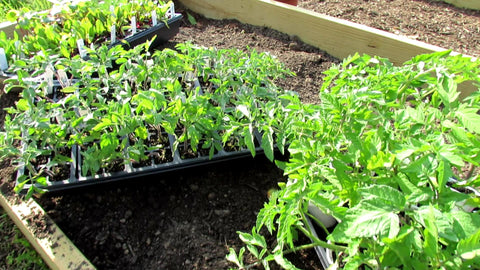You can grow wonderful tomato transplants without grow-lights and you can use this same method with other flowers, herbs and vegetables. It is pretty simple. The video explains the principle and shows you examples of vegetables grown using this method. In short... take the seed flats out during the day when it is not freezing and conditions are good and bring them in at night.

You need grow-lights indoors because a window doesn't provide enough direct light and your seed starts will get tall and leggy. Taking them outside during the day, addresses this issue by exposing them to the direct sun. Make sure they are not placed in a shady area. The goal is direct sun.
Indoor seed starting has its place and I use it every year. But you may not have the time, resources or space to set up a grow-light station. You can simply plant a flat of tomatoes or other plants and put them out during the day and bring them in at night. This method works because you are bringing the plants in, late in the afternoon, and putting them out again the next morning. They get 10-14 hours in your house where it is warm. This keeps the root systems warm and allows the plants to develop nicely over a 3 to 4 week period.
Start your flats indoors and keep them indoors until you see the first seed germinate and break the surface. When this occurs, they should be placed outside daily, as long as whether permits. If they can't be outside for a full day, place them out there for as many hours as possible.
Unlike indoor vegetable seed starts, your outdoor seed starts will not need to go through the process of getting acclimated to the sun and outdoor weather. This is a huge time saver and these plants will be ready to go in your garden as soon as you are ready to plant.
You can put them outdoors as long as the temperatures stay in the upper 30's. The perfect range is 45 to 70 degree days. Some conditions to keep in mind and adjust accordingly are:
Heavy Rains: Will splash the seed starting mix out and damage plants. Make sure they are under cover.
Light Prolonged Rains: Can flood the seed flats. As long as you dump the excess water out that day, they will be fine.
Heavy Winds & Temperatures Under 45 degrees: This combination can bring the wind chill down close to freezing and damage plant leaves.
70 Degree Days & Full Sun: Your seed cells can dry out quickly when your plants are larger, the days are warmer and the sun is out.
The flats that are in the video were seed started on 4/4/2019 and planted into the garden on 5/2/2019. Germination for most of the vegetables plants occurred about 7 days after planting. That is about 3 weeks worth of growth. You want to have your seed starts planted, in the garden, somewhere between 3-4 weeks after they germinate. Time your seed starts accordingly, as you don't want them to get root bound and stressed in the seed starting cells.
By Gary Pilarchik May 03, 2019

Leave a comment